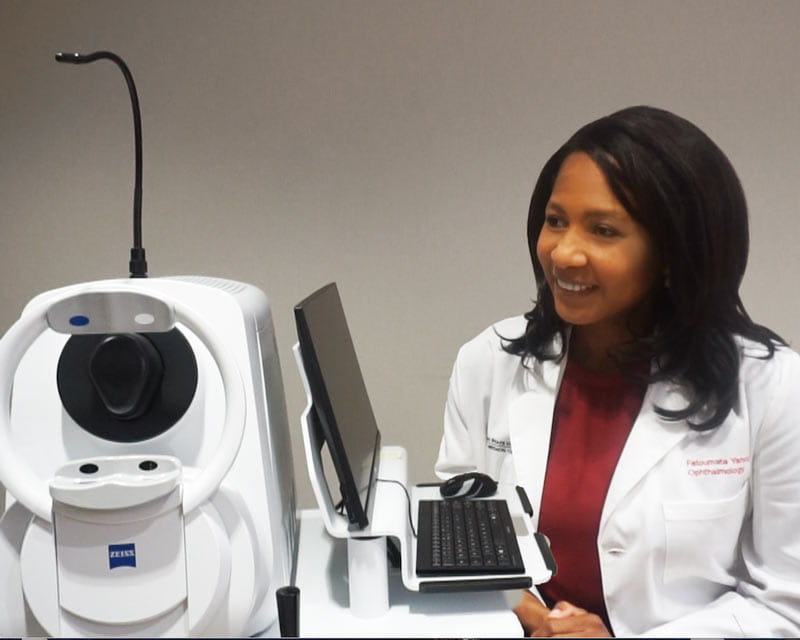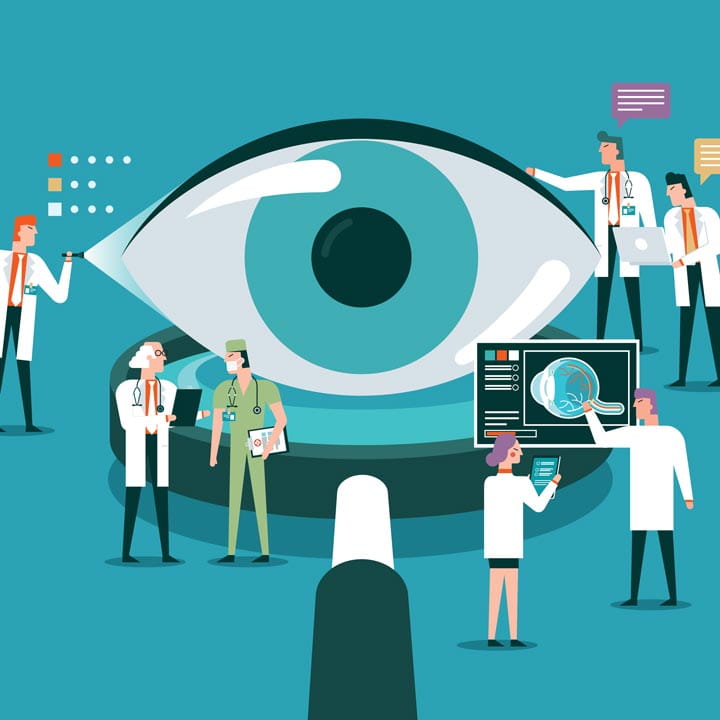
Swept-source OCT angiography reveals exquisite details of ocular structures
 A new National Institutes of Health/National Eye Institute (NEI) P30 Core Grant awarded to The Ohio State University’s Department of Ophthalmology and Visual Sciences (DOVS) will support shared resources and facilities for use by multiple scientists across campus who conduct vision research.
A new National Institutes of Health/National Eye Institute (NEI) P30 Core Grant awarded to The Ohio State University’s Department of Ophthalmology and Visual Sciences (DOVS) will support shared resources and facilities for use by multiple scientists across campus who conduct vision research.
Called The Ohio State University Vision Sciences Research Core Program, the P30 grant funds three research areas with priority among NEI-funded clinicians and scientists working across several Ohio State colleges. The award is one of approximately 40 P30 grants in the nation.
Department Chair Sayoko Moroi, MD, PhD, and her team applied for the P30 grant because she experienced the P30 benefits working at her previous institution.
“There is value in having certain centralized research services,” Dr. Moroi says, “because such expensive and specialized equipment augments research productivity for faculty. While individual R01 grants are very important, their budgets are limited in what instruments can be purchased.”
NEI P30 grants are five-year awards designed to enhance research productivity of R01-funded investigators and assist in preliminary data to support vision research for a new R01 proposal.
As Dr. Moroi and her team prepared the application, they surveyed the vision-scientist stakeholders across the Ohio State campus about their research needs. The P30 grants are highly competitive, with a minimum of three core modules for an application. Each module is reviewed independently as a separate grant.
The NEI typically awards P30 grants to individual departments. Ohio State’s Vision Sciences Research Core Program extends across multiple colleges that include the colleges of Medicine, Optometry, Veterinary Medicine, Engineering, and Arts and Sciences as well as to Nationwide Children’s Hospital.
Three modules are organized by core theme research areas:
The leadership for each core includes faculty from ophthalmology and other colleges and departments. These interconnections create opportunities to increase data diversity, include more disciplines and encourage innovative partnerships.
“I want to break down those silos and build bridges,” Dr. Moroi says.
Core A focuses on physiological and structural data gathering from the cellular level to animal models of eye diseases. The work often requires expensive equipment and technical expertise that individual researchers can’t afford but institutions can, such as:
At Ohio State, some of the advanced equipment will be duplicated to serve two locations — one housing small animal research and the other for large animal studies.
The Core A team, directed by DOVS faculty Colleen Cebulla, MD, PhD, and Department of Neuroscience faculty Andy Fischer, PhD, will also provide consulting expertise to scientists and labs that need additional analysis or help with developing specific research methods. Such technical support can also assist funded scientists in completing additional studies within their funded projects, Dr. Moroi says.
For example, when studying macular degeneration, glaucoma or inherited retinal dystrophy in animal models, a researcher may study one aspect of a condition, such as histology. The P30 cores offer the ability for the same scientist to expand their work by taking in vivo pictures of the animal’s eyes over time and some electrophysiologic functions of the diseased tissues or eyes.
“This P30 grant will enhance research of funded investigators and also help faculty without grants who need critical pilot data in order to write a strong new grant proposal,” Dr. Moroi says.
Today’s scientific studies commonly encompasses “-omics” research, from genomics, proteomics, lipidomics and metabolomics. Dr. Moroi says lab teams develop assays and create eight to 150 gigabytes of data but may not know how to analyze this volume of data.
The Biostatistics, Bioinformatics and Genetic Analysis Core Program provides traditional biostatistics, data analysis and large-scale genomic data mining service in-house for faculty and researchers who need it. The team provides advanced computational analytics and specialized software for such statistical genetics.
DOVS faculty Raymond Gao, PhD, and College of Optometry faculty Lisa Jordan, PhD, MS, lead this core. Dr. Gao brings a strong genetics and analytical background and supervises graduate students who analyze research data. Dr. Jordan is an expert in biostatistics and will assist researchers in experiment design and data analysis.
As the Core B leadership team helps design studies and interpret findings, they also enhance their own scholarship through teamwork, Dr. Moroi says.
“The intellectual effort and productivity among the core leaders will help our department and others with measuring key outcomes of new grants and publications.”
Artificial intelligence and machine learning are making important advances in many fields of study. The Image Analysis and Data Science core will provide expertise in machine learning and deep learning. This includes analyzing data from eye imaging, eye tests and electronic health records.
“The data science field, or ‘big data,’ requires a combination of certain skill sets and knowledge that blend clinical acumen, computer science, health sciences, social scientists, economics and public health,” Dr. Moroi says.
College of Optometry faculty Nathan Doble, PhD, and College of Engineering faculty Srinivasan Parthasarathy, PhD, will combine their expertise in imaging and computer science to provide investigators data science analytic capabilities. The team also will leverage access to the Translational Data Analytics Institute and the Center for the Advancement of Team Science, Analytics and Systems Thinking in Health Services and Implementation Science Research.
“Beyond providing data science services to investigators, we have the long-term ambition to create high-quality and robust data commons so that other scientists can apply innovative analytical methods on the dataset,” Dr. Moroi says. “Our aspiration is to develop a common data architecture for our vision research community and be able to share it outside of Ohio State.”
As principal investigator, Dr. Moroi also leads an administrative core for the P30 grant. She’s responsible for ensuring that each core follows proper fairness and governance guidelines and responsibly delivers products requested by researchers.
This P30 grant will be a strong recruiting advantage and a retention incentive of faculty and scientists.
“Sharing this news of our new NEI P30 grant is a big hit when I inform faculty candidates,” Dr. Moroi says. “This grant is a strong outcome measure and vote of confidence from NEI of the vision research environment that we are building together at Ohio State.”
Dr. Moroi and her team chose their three cores strategically based on survey data from the Ohio State vision research stakeholders. Many traditional NEI P30 at other institutions had a machine shop core. However, there’s an outstanding centralized service within the Ohio State College of Engineering’s Center for Design and Manufacturing Excellence so vision scientists will leverage this service.
When the department applies to renew its P30 grant, the progress report will provide productivity outcome metrics within each core, including services used by faculty, publications achieved and new grants accrued.
“As technology evolves, the types of cores we propose may expand,” Dr. Moroi says. “We will be fluid to respond to the cutting-edge methods that will help our vision scientists advance their fields with our common goal to prevent blindness and advance quality of health and life.”